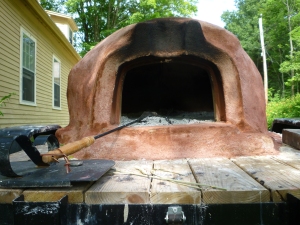Yesterday was way too hot to work outside. Shying away from imminent heat exhaustion, I spent the whole day in the kitchen – milling, packaging, and labeling einkorn flour to ship across the country. Eli’s clients are from all over the country – Colorado, Oregon, California… What she’s operating in right now is a very niche market – gluten-intolerant artisan bakers. It was interesting to see where the orders were coming from, and imagine who had sought out the Heritage Wheat Conservancy looking for wheat that could side-step their dream shattering allergies.
Flights of fancy aside, for the better part of the day I made my first pita loaves. Exciting, because I have quarts of homemade hummus and hummus requires pita like coffee needs pie. So I picked a simple recipe out of an awesome Flatbreads cook book. I didn’t write it down but it went something like this:
5-6 Cups All Purpose Flour (or half wheat, half white)
2 tsp. yeast
2 tbsp olive oil
2 tbsp salt
2 1/2 cups of water
Well, I started with good intentions of following directions – but I had to reduce the amount because I didn’t want to use too much einkorn flour so 5-6 cups turned into 4 cups of flour. Since my math on the spot skills are dismal at best all the amounts were results of my tinkering with the moisture of the dough and white to einkorn flour ratios until the dough held together nicely and was not sticky. It might be difficult to reproduce, I definitely want to get recipes and use them closely enough to have the basic form down pat – then start improvising. Next time, anyway,
My recipe looked more like this:
2 c. einkorn flour
2+c. hi-gluten white flour (i threw a bunch in at the end so its hard to be precise)
1 tsp. dry active yeast
1 tbsp olive oil
1 tbsp salt
2(?) c. lukewarm water
1 heaping spoonful sourdough starter
Foremost, the yeast has to be activated. Warm water to about blood temperature, any hotter could kill the yeast organisms. Sprinkle yeast on top of water and stir, allow to sit for 5-10 minutes. Mix the flours together, and add 2 cups mixed flour into the warm water – stir well (the book said 100 strokes in one minute) to create a “sponge” and allow to sit and ferment for 20 minutes – 2 hours (the longer the better). Once plenty of bubbles are visible on the surface of the “sponge” add olive oil and stir. Sprinkle salt on top of sponge, this stops the fermentation process. Add the rest of the flour and mix until you get a fairly strong dough. At this point I divided the dough into fist sized balls and on a floured surface, used my fingers to stretch and flatten the dough until they were a nice pita shape (amorphous and round); but you can really do any size you want. Then cover the dough with plastic wrap and allow to rise for an hour and a half or more.
After the dough has risen, I found it best to degas it by pressing down with your palms and fingertips to flatten the dough. I baked a few without degassing or “punching down” and they were more of a foccacia than a pita. At this point I also had to divide the circles a few more times because of space constraint, but they were pretty easy to reshape – it’s just important to smooth out the creases or “seams” in the dough. Place dough on a floured cookie sheet and season. I brushed each bread with olive oil and sprinkleld za’ater seasoning on top.
To bake: preheat oven to 450-500 degrees. Bake for up to 10 minutes, check at 2-4 minute intervals. When the pita balloons, you are getting close. I waited until mine browned to take them out, the crust was harder than most pita but it was soft and good inside.
It turned out really well. The sourdough and einkorn make a delicious combination that is tangy, nutty and savory. The ones that ballooned well make great pocket breads. The texture is somewhere between pita and pizza crust, & it stayed nice and moist inside. So far so good! I’m want to have a bread recipe book done by the end of the summer. Maybe one of these days I’ll work at a bakery. I think that would suit me just fine.
Next time I want to try it in this thing –


